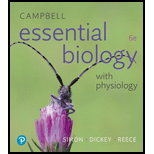
Campbell Essential Biology with Physiology (6th Edition)
6th Edition
ISBN: 9780134711751
Author: Eric J. Simon, Jean L. Dickey, Jane B. Reece
Publisher: PEARSON
expand_more
expand_more
format_list_bulleted
Concept explainers
Question
Chapter 3, Problem 23BS
Summary Introduction
To explain: The useful and harmful effects of using insecticides, fungicides, and weed killers.
Concept introduction: Insecticide, fungicides, and weed killers are all chemical compounds manufactured in factories for pest control. They are most widely used in agriculture. These compounds can be synthetic, organic, or inorganic.
Summary Introduction
To determine: Whether the use of pesticides, fungicides, and weed killer is good or bad.
Concept introduction: Insecticide, fungicides, and weed killers are all chemical compounds manufactured in factories for pest control. They are most widely used in agriculture. These compounds can be synthetic, organic, or inorganic.
Expert Solution & Answer
Want to see the full answer?
Check out a sample textbook solution
Students have asked these similar questions
Anwser these
Discussion Questions:
Part One
Why were the plants kept in the dark prior to the experiment? Why is this important?
Why is it important to boil the leaf?
Explain why it was necessary to use boiling alcohol?
What is the purpose of the iodine?
Part Two
What was the purpose of keeping the leaf in the dark and then covering it with a cardboard cut-out?
What conclusions can you draw from this part of the lab?
Part Three
7. In this experiment what was the purpose of adding the soda lime?
8. Why was a sealed bag placed around each plant?
9. What happened in the control plants?
10. What was the result on photosynthesis?
Part Four
11. Why was a variegated leaf used in this experiment?
!2. What conclusions can you draw about starch production in a variegated leaf?
How did the color differences between the two bacterial species you used in this experiment help you determine if the streak plate method you performed was successful?
series of two-point crosses were carried out among six loci (a, b, c, d, e and f), producing the following recombination frequencies. According to the data below, the genes can be placed into how many different linkage groups?
Loci
a and b
Percent Recombination
50
a and c
14
a and d
10
a and e
50
a and f
50
b and c
50
b and d
50
b and e
35
b and f
20
c and d
5
c and e
50
c and f
50
d and e
50
d and f
50
18
e and f
Selected Answer:
n6
Draw genetic maps for the linkage groups for the data in question #5. Please use the format given below to indicate the genetic distances.
Z
e.g. Linkage group 1=P____5 mu__Q____12 mu
R
38 mu
5 Linkage group 2-X_____3 mu__Y_4 mu
sanight
Chapter 3 Solutions
Campbell Essential Biology with Physiology (6th Edition)
Ch. 3 - Prob. 1SQCh. 3 - Monomers are joined together to form larger...Ch. 3 - Prob. 3SQCh. 3 - Prob. 4SQCh. 3 - When two molecules of glucose (C6H12O6) are joined...Ch. 3 - One molecule of dietary fat is made by joining...Ch. 3 - Prob. 7SQCh. 3 - Prob. 8SQCh. 3 - Prob. 9SQCh. 3 - Most proteins can easily dissolve in water....
Ch. 3 - Prob. 11SQCh. 3 - Prob. 12SQCh. 3 - Name three similarities between DNA and RNA. Name...Ch. 3 - Prob. 14SQCh. 3 - Prob. 15IMTCh. 3 - Prob. 16IMTCh. 3 - Prob. 17IMTCh. 3 - A food manufacturer is advertising a new cake mix...Ch. 3 - Prob. 19PSCh. 3 - Prob. 20PSCh. 3 - Prob. 21BSCh. 3 - Prob. 22BSCh. 3 - Prob. 23BS
Knowledge Booster
Learn more about
Need a deep-dive on the concept behind this application? Look no further. Learn more about this topic, biology and related others by exploring similar questions and additional content below.Similar questions
- What settings would being able to isolate individual bacteria colonies from a mixed bacterial culture be useful?arrow_forwardCan I get a handwritten answer please. I'm having a hard time understanding this process. Thanksarrow_forwardSay you get AATTGGCAATTGGCAATTGGCAATTGGCAATTGGCAATTGGCAATTGGC 3ʹ and it is cleaved with Mspl restriction enzyme - how do I find how many fragments?arrow_forward
- Which marker does this DNA 5ʹ AATTGGCAATTGGCAATTGGCAATTGGCAATTGGCAATTGGCAATTGGC 3ʹ show?arrow_forwardThe Z value of LOD for two genes is 4, what does it mean for linkage and inheritance?arrow_forwardBiology How will you make a 50-ul reaction mixture with 2uM primer DNA using 10 uM primer DNA stocksolution and water?arrow_forward
- Biology You’re going to make 1% (w/v) agarose gel in 0.5XTBE buffer 100 ml. How much agarose are you goingto add to 100 ml of buffer? The volume of agaroseis negligible.arrow_forwardBiology How will you make a 50-ul reaction mixture with0.2 mM dNTP using 2-mM dNTP stock solution andwater?arrow_forwardBiology What is 200 pmole/uL in Molar concentration?arrow_forward
arrow_back_ios
SEE MORE QUESTIONS
arrow_forward_ios
Recommended textbooks for you
- Essentials of Pharmacology for Health ProfessionsNursingISBN:9781305441620Author:WOODROWPublisher:CengageSurgical Tech For Surgical Tech Pos CareHealth & NutritionISBN:9781337648868Author:AssociationPublisher:Cengage
 Comprehensive Medical Assisting: Administrative a...NursingISBN:9781305964792Author:Wilburta Q. Lindh, Carol D. Tamparo, Barbara M. Dahl, Julie Morris, Cindy CorreaPublisher:Cengage Learning
Comprehensive Medical Assisting: Administrative a...NursingISBN:9781305964792Author:Wilburta Q. Lindh, Carol D. Tamparo, Barbara M. Dahl, Julie Morris, Cindy CorreaPublisher:Cengage Learning




Essentials of Pharmacology for Health Professions
Nursing
ISBN:9781305441620
Author:WOODROW
Publisher:Cengage

Surgical Tech For Surgical Tech Pos Care
Health & Nutrition
ISBN:9781337648868
Author:Association
Publisher:Cengage

Comprehensive Medical Assisting: Administrative a...
Nursing
ISBN:9781305964792
Author:Wilburta Q. Lindh, Carol D. Tamparo, Barbara M. Dahl, Julie Morris, Cindy Correa
Publisher:Cengage Learning